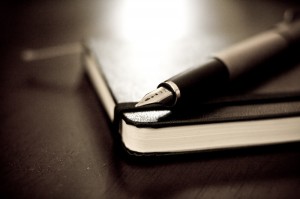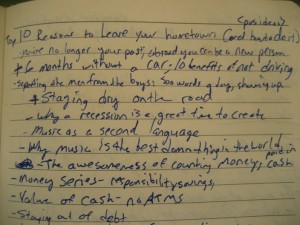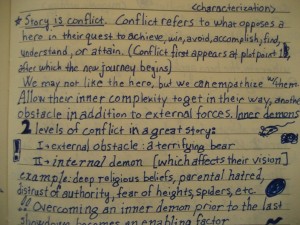
Three years ago, I received a box of dusty old books. Most were over 50-120 years old. One of the books was Coleridge’s ‘Rime Of the Ancient Mariner.
Everything about the book suggested attention to detail and craftsmanship: the blue embossed binding, the lithographs of castles, flowers and vines that surrounded every page, and a personal note in the front.
The note read ‘To my dear Emma, May you enjoy this as much as I did. Joseph. March, 1882.’ It was written in a Spencer script, the letters smooth and flowing. Just a simple message, but it looked so nice it seemed to be a part of the book. I wish I had pictures to share, but the book is back in the U.S.
At the time, I wondered how people wrote like that and why no one writes like that today. The answer is pretty simple: in the past, good handwriting was an important skill, just like typing or knowing how to make lolcats in Photoshop. Before typewriters and computers, you were judged by the quality of your handwriting. Quality handwriting was drilled into students through hours of exercises.
Today, teaching and learning quality handwriting is almost an afterthought. I don’t remember exactly how much time I spent learning penmanship skills, but it wasn’t enough. And I had a disadvantage: I’m left-handed. I was told to use my right hand or to write with my book turned sideways. That’s like telling a cow not to moo (Click here to learn more about the relationship between the word ‘left’ and all things evil).
Now, two decades later, I’m sick of my ugly handwriting.
Not only do I want to have better general penmanship, I want to improve my cursive. Why would I want to improve what a New York Times Op-Art article basically called an obsolete style?
In a lot of U.S. school systems, especially since the 1980s, some decision makers felt that keyboards and technology would replace the need for handwriting. By the time these kids are adults, the thinking went, you’ll have to buy ink pens in antique stores and handwriting won’t matter. Also, as schools sought to cram more content-based materials in, basic skills like handwriting received less and less time in the classroom.
I don’t deny that typing and tech skills are important. The faster and more accurate you can type, the better, and because of my early access to Apple IIs, I am comfortable with all types of computers. But, the mistake here is believing that typing is a replacement for writing. No. Typing and writing are like singing and dancing. One isn’t a substitute for another.
Why Write By Hand?
The pen and paper aren’t going anywhere. As long as we are thinking people who engage with the world around us, as long as we have love letters to write, bureaucracies to deal with, and dirty messages to write on bathroom stalls, we will need to write things down.
Physically writing things down is like thinking on paper. Spiderman’s hands shoot webs. Writers’ hands shoot ideas, and for me the difference between drafting by hand and using a keyboard is like the difference between using an assault rifle and an RPG to kill a field mouse; they both get the job done, but one is a whole lot less messier.
Before I even start typing a post, I usually write all my ideas out onto a mind map, then use that to make an outline. Writing on paper, I’m not constrained to put things in a linear order. And, if I want to draw little sketches of the dead plant on my desk, I can do that, too. While typing, I have to interface with a keyboard and abide by its restrictions.
Writing on paper is a more visceral and physical experience, unmediated by screens and machines.
Why Have Good Handwriting?
Besides assisting my admittedly puny mind, I would also argue that good penmanship increases the usefulness and impact of whatever I write. If I’m taking notes on some topic, and I take the time to make the notes look decent, I get a lot more out of the notes and feel less resistance to go back and reread them.
Writing neatly will initially take a few moments longer, but it will save time if and when you need to read over what you’ve written. If you’re typing something you’ve written by hand but struggling to decipher the words, squinting, struggling, turning the paper upside down, you’re spending a lot of extra time. Had you written a little slower initially, reading what you had written would be far simpler.
If you write a note to yourself that you can’t read, it doesn’t do you a damn bit of good, does it?
Going further, in some occupations good handwriting can save lives. In 1999, RamonVasquez died because the pharmacist misread his doctor’s ugly-ass handwriting (link).
There is the visual appeal of looking at a page of nicely printed script. A well-printed page has more perceived value, both for yourself and others. Sadly, if you have messy handwriting, the people you’re writing to will probably think you’re a moron. Of course, you know better, but still.
Let me argue the counterpoint as well: good penmanship isn’t always important. Quality should vary depending on your purposes. If you’re just trying to get some ideas out as quick as possible, don’t let good handwriting stand in your way. Quick and dirty has its place, and you can’t let a properly formed ‘a’ slow you down. This is when cursive comes in handy. For me, legible cursive is still a lot faster than anything else.
For the past couple months month, I’ve been trying to learn all I can on improving my own handwriting. Here are some things I’ve found useful so far.
Tips for How to Improve Your Handwriting and Penmanship
Write Slower For me, this was the most easiest and most effective way to improve my handwriting. Most writing is done with little regard to the actual act of dragging a pen across paper. By simply slowing down, being conscious of, and paying attention to this act, you should see some immediate improvements.
Write Bigger You don’t have to make balloon letters, but slightly bigger letters are easier to make and easier to read. Don’t worry about taking up too much space. You can always buy more paper.
Back to Kindergarten Sometimes you’ve got to go back to the basics. Print off some guide sheets and practice basic letters. The Times article I mentioned earlier has instructions for a nice italic font.
Get Your Body Into It Several sites recommend using using your shoulders and arm to make letters instead of using your hand. This helps a bit, but it requires you to sit at a desk and have good posture. I like to write while slouching on the couch.
Get an Awesome Pen Not all pens are created equal. Find a pen that doesn’t require a lot of pressure. I like Pilot G-2 07s, and I hear fountain pens (like the one in the picture) are good, but I’ve never used one.
Think of Writing as Typography and Drawing As an experiment, I tried to write in a Garamond script. Doing this, I had to start thinking of printing letters as drawing rather than writing. The results were impressive. If you’re patient, try copying some typeface style sheets. Smashing magazine has a nice list here.
Experiment The way you hold your pencil and your wrist will affect the way you write. Try different hand positions, writing styles, slants, etc until you find one that works for you.
Practice, Practice, Practice Undoing years of bad habits will take time, but the results are worth it.
Further reading:
IAMPETH is a non-profit that promotes beautiful handwriting and calligraphy. They have an excellent selection of lessons in Spencerian Script, Copperplate, and skills as well as printable guide sheets.
Paperpenalia has some solid tips on improving handwriting, especially the ones about using your shoulder muscles. I’m not sure about the pens they’re selling, though.
Before and After Shot


The photo on the left is from the middle of June. As you can see, it looks like roadkill. The one on the right is from the end of September.
Over to you
How is your handwriting and penmanship? Do you prefer to type and handwrite drafts? Can you still write in cursive? Is cursive obsolete? Am I wrong that good handwriting is useful? Will electrodes on our brains connected to printers eventually replace old school handwriting? Holler back.
Top of the page photo credit: The Mad Guru

Comments on this entry are closed.
Hi Seth,
Just have read your blog with enthusiasm.
It’s something which is bothers me too… Handwritings…
Nowadays when someone is write you a note you can’t read it as you would. It is like the computer take over the good handwritings. And it’s irritating me how bad too much people really write (when they must write).
I have to complement you about the progress you’ve been through because I see a difference between the two examples.
Myself… I wasn’t the best handwriter when I was a pupil but I’ve changed my handwriting when I was a teenager, because it felt like drawing to me. Yes, I took the time for it and practice over and over again. I’ve realised I’ve got almost 5 different handwritings at the moment. Maybe it is because I’ve artistic influence in my hand?
Anyway I wish I could show you my handwritings and my preference is to write by hand… it’s like a kind of personal presentation of yourself to someone else and (ofcourse) it’s much personal too.
Writing takes more time to do than press some buttons behind a notebook.
You’ve taken a nice subject!
Greetings from the Netherlands,
Toya
I love an awesome pen, and I miss handwriting. My penmanship has suffered drastically in the last ten years since I started using the computer more for composition. Somehow, I’m still surrounded by notebooks, but I can barely read them. I really should get back to it because it’s a far more tactile experience. Thanks for the reminder (and you make handwriting sound so sexy!).
That simile about killing a field mouse with a RPG really swept me away.
@Toya: That’s right! When I started thinking of handwriting as drawing, I saw a big improvement.
@Melissa: If I have made handwriting of all things sound sexy, then I’ve done my job 🙂
@Lineberry: I’m glad you didn’t write ‘it blew me away.’ Too corny.
I just read this article to my son. I homeschool, and I’ve been trying to get him to slow down and use good penmanship. I grew up using d’nealian, and I think it’s a great program. I heard about the trend for dropping penmanship in public schools, and I think that’s just nuts. I’m sure the kids love it, though. I hated handwriting class in school.
I think your description of your before and after shot is backwards…the one on the right looks much nicer. The left is roadkill.
My son says: The writing that was in the book (Spencher script) looks pretty cool. I’d like to be able to write like that, too.
By the way, fountain pens are awesome! I got one in Germany, and it really made me slow down and write neater. Unfortunately, it was a cheap one, and I’ve messed up the tip (nub?) and I can’t use it anymore. I want a nice one someday. And then I want to fill up a pretty journal with pretty handwriting from my pretty pen. lol.
Hi Leighann. I started looking around for a good fountain pen, but I don’t really know what I’m looking at. If I buy one, I’d like to buy a good one, but I don’t know if I could find replacement bits when I get back to the states….Sounds like the same situation you’re in.
Great article, I really like how you decided to take action on the handwriting. I have been working on mine for years, even created a “font” for myself. One way that I practiced improving my handwriting was by keeping a journal in an unlined notebook.
Put “improving handwriting” into Google and you will come up with several online articles and at least two books. There is an oft-quoted curriculum from Iceland (or maybe Norway) that details how to teach children a simple italic hand based upon an attempt to standardize 13th Century Carolingian scriptoria.
I have an excellent little book called “Better Handwriting” by Rosemary
Sassoon and S.E. Briem. Highly recommended.
Google also: “S. E Briem” or just head to briem.net
And… everyone should have at least one excellent fountain pen! Entry level disposables are only US$4.00.
david boise ID
Your handwriting sample on the left gives me hope! It looks almost exactly like my own handwriting, which I have always hated. My teachers were more concerned with making me hold my pencil in a manner which was uncomfortable to me than helping me actually write legibly. (Put your thumb between your index & middle finger as if you’re pretending to steal someone’s nose. That’s how I hold a pen).
I will continue to practice, and try to SLOW DOWN, as I think that’s my biggest problem.
thanks for the article!